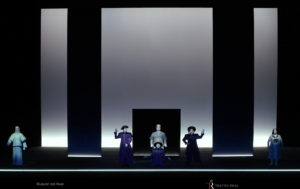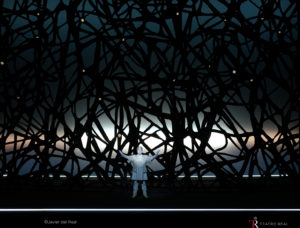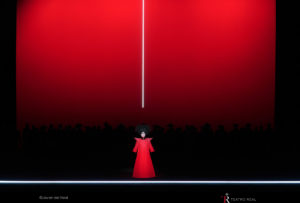Everything began to deteriorate in 1906, with the passing of Giuseppe Giacosa – the co-creator (together with Luigi Illica) of Puccini’s greatest operatic successes: La Bohème, Tosca and Madama Butterfly. Two years later, a scandal broke out: Elvira Puccini accused her husband of a romance with their youthful servant girl, Doria Manfredi. It seemed that she had strong arguments in hand. The composer had already previously earned himself a reputation as an incorrigible ladies’ man, and Doria completely idolised him. When Elvira started a rumour that she had caught the two in flagranti, the girl committed suicide. The autopsy showed that Doria had died a virgin. The servant’s family brought a lawsuit, Elvira was found guilty, Puccini negotiated with the lawyers for the conviction to be set aside, and paid Manfredi a princely sum in damages. The tragedy of Doria tormented him to his life’s end. The composer, who had always made it his goal for the audience to cry at performances of his operas, had himself fallen victim to an intrigue that deceptively resembled Illica and Giacosa’s earlier libretti. And he was horrified to realise that the world, on the brink of the Great War, had occupied itself with other matters. ‘It is very difficult to write an opera now,’ he complained in a letter to Illica. The American success of La Fanciulla del West, created in collaboration with other librettists, turned out not to be reproducible in Europe. La Rondine – after its world première in 1917 – quickly fell into oblivion. Subsequent ideas for pieces based on motifs from works by Shakespeare, Balzac, Dickens, Kipling and Tolstoy landed in the circular file.
Finally, Puccini decided to set forth into the unknown. In 1919, he invited Italian journalist, theatrical critic and playwright Renato Simoni – who was friendly with Giuseppe Adami, the librettist for La Rondine and Il Tabarro, written a year later – to Torre del Lago. Simoni proposed that Puccini take a journey into the land of myth. ‘And Gozzi? What if we just returned to the œuvre of Gozzi?’ The composer agreed to the writer’s suggestion. He asked a certain lady who had seen a famous production by Max Reinhardt at Berlin’s Deutsches Theater back before the war to send him photos from that show. He decided the matter was worth his interest – on the condition that the intrigue be simplified and shown through the prism of the contemporary audience’s sensibilities: ‘Simoni’s, Adami’s and mine’.
Andrea Mastroni (Timur), Gregory Kunde (Calaf), and Yolanda Auyanet (Liù) – with Joan Martín Royo (Ping), Vicenç Esteve (Pang), and Juan Antonio Sanabria (Pong). Photo: Javier del Real
The libretto of Turandot diverges far from its prototype. It even conflicts with Schiller’s Romantic, moralizing adaptation produced in Weimar by Goethe in 1802. One could risk the assertion that Puccini’s last opera is an homage to poor Doria, who took on the form of Turandot’s Liù – unhappily in love with Calaf and faithful unto death – who brings to mind associations with the female leads in the composer’s earlier works: the crueler the fate prepared for them together with the librettists, the more Puccini pitied them. Both the soulless princess and her unyielding admirer – unlike Liù – impress the viewer as beings not of this world, to whom only the final ‘transfiguration’ can impart more human characteristics. And that was precisely Puccini’s downfall. He struggled with the protagonists’ final duet for months, unaware that his own days had been numbered by throat cancer. He agreed only to the fourth version of the last scene, sent by Adami in October 1924, after four years of work on the piece as a whole. Next to a barely-sketched melody from Turandot’s part, he made an intriguing note: ‘poi Tristano’ – ‘then Tristan’. Researchers are wracking their brains to this day, wondering what he had in mind. To finish the opera with an allusion to Wagner’s masterpiece? Or perhaps – more probably – to throw down the gauntlet before Wagner, to describe the princess’ transfiguration by love in a completely different sonic language, to blaze completely new trails for Italian opera, which over the past century had become ossified? We shall never find out. At the world première, Toscanini lay down his baton after Liù’s death scene.
Turandot is one of the 20th century’s unfinished masterpieces. A mysterious work – on the one hand, literally boiling with melodic imagination, as if Puccini, sensing his impending death, was trying to fit in material for several operas which would no longer have the chance to be written; and on the second, surprisingly innovative, combining references to Stravinsky, Richard Strauss, Schoenberg and the French Impressionists with allusions to the form’s tradition filtered through a fin-de-siècle sensibility; and on the third, a brilliant failure, a musical expression of powerlessness in conflict with a subject as tempting as it was risky for an artist lost in the land of fairy tales. And like most 20th-century operatic masterpieces – including those that are finished – it requires a cast that is all but impossible to put together, a highly competent conductor and a stage director gifted with extraordinary imagination.
Gregory Kunde. Photo: Javier del Real
The decision to entrust the new production of Turandot at Madrid’s Teatro Real to the care of Robert Wilson turned out to be more than appropriate. The aesthetic language of this avant-garde classic’s productions arises out of the most noble traditions of Japanese theatre – clarity of space, an economy of acting closely bound up with the symbolic sphere, sensitivity to colour and the tiniest changes in lighting. Wilson creates a theatrical illusion with simple means: through the use of a cyclorama, movable panels, abstract projections, simple props that all the more bring out the gestural language he has elaborated – superficially foreign, but sufficiently precise and suggestive that its figures soon combine into a coherent semantic whole. He conveys the characters’ emotions with micro-movements of the body; he paints physical sensations with fields of light and color. After a moment of disorientation, even the untrained viewer begins to associate trembling fingers with Calaf’s anxiety; the flashes of red taking over the entire stage, with the pain of Liù under torture; the grotesque dances of the three Mandarins, drawn from the commedia dell’arte, with the inhuman etiquette of Turandot’s court. The entire concept is dazzling in its visual beauty, which despite this does not eclipse the individual scenes; among others, the symbolic death of the little slave girl, who slowly bows her head over folded hands – like Buddha sinking into Nirvana – after which she literally departs into non-existence, reeling, less and less visible, among the members of her own funeral procession.
Wilson’s staging is also supportive to the singers – for most of the show, they are set facing the audience, unencumbered by superfluous props, creating their roles in a comfortable acoustic space. The pre-première period did not pass without certain turbulences in the cast – Nina Stemme, laid low by illness, withdrew from the role of Turandot; there was also a last-minute substitution in the role of Liù. My fears notwithstanding, Irene Theorin built a convincing character of the cruel princess – with a voice of sometimes rather unpleasant colour, but intonationally secure (despite a wide vibrato), rich in overtones and skillfully diversified in expression (e.g. the superbly shaded phrase ‘Principessa Lou-Ling’ in the aria ‘In questa reggia’). I was somewhat less impressed with Yolanda Auyanet, who is very musical and technically competent, but possesses a soprano too dark and dense for the role of Liù. The extraordinarily well-favoured, subtly-delivered bass of Andrea Mastroni was perfect in the role of Timur. My sincere admiration goes to the three Mandarins – Vicenç Esteve (Pang), Juan Antonio Sanabria (Pong), and especially the phenomenal Joan Martín-Royo (Ping) – ideally matched in vocal terms and, unlike the rest of the cast, saddled by the stage director with a whole host of complex acting tasks, in which they acquitted themselves impeccably. But the true hero of the evening turned out to be Gregory Kunde (Calaf). This singer is unstoppable: after a forty-year stage career, the bel canto master is more and more often taking on heroic roles – and that, with superb results. His tenor, although it has become slightly duller in the lower register, is still impressive in its large range, extraordinary culture of phrasing and freedom of vocal production in the highest notes.
Irene Theorin (Turandot). Photo: Javier del Real
Nicola Luisotti led the orchestra of the Teatro Real with vigour, at very brisk tempi, but too often emphasizing juiciness and power of sound – at the expense of nuances in colour and texture. It also sometimes happened that the sound of the chorus was drowned out by the massive orchestra, which in the case of Turandot – which is exceeded in its masterful painting of the crowd’s moods probably only by the operas of Mussorgsky – should be considered a serious interpretative flaw. All of the above notwithstanding, the fact remains that the ‘Gira la cote, gira, gira!’ scene sent shivers up and down my spine.
The Madrid Turandot was performed with the finale by Franco Alfano, who conscientiously collected the dead composer’s notes and, based on them, whipped up a completed version that was correct but far from Puccini’s unfulfilled intention. That intention was also missed by Luciano Berio, the author of a considerably more interesting and much more rarely-played reconstruction from 2001: he took the indication ‘poi Tristano’ to heart and ended the opera with an almost literal quote from Wagner. The longer I compare the two versions, the better I understand Toscanini, who presented the work in its unfinished form at the world première. Out of respect for Puccini, who thought about the solution to his Turandot’s final riddle for so long that death finally overtook him.
Translated by: Karol Thornton-Remiszewski



